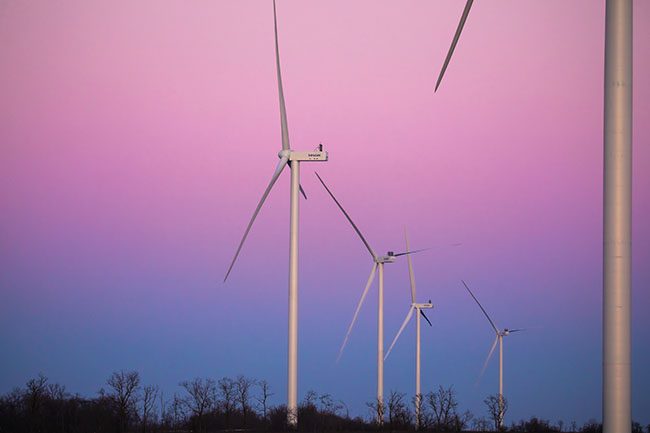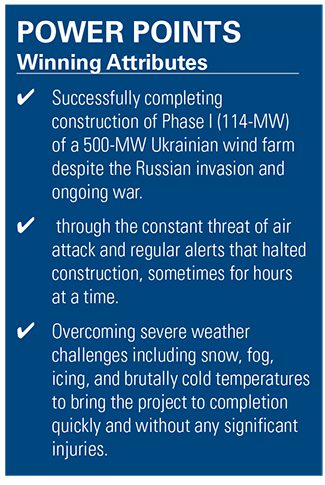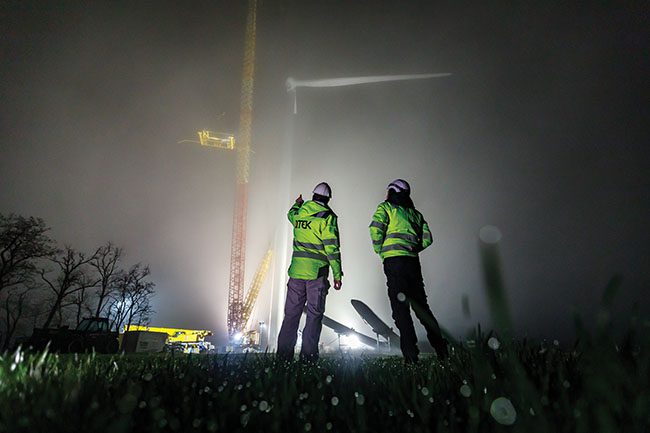A Symbol of Courage and Invincibility: DTEK Completes Wind Farm Despite War
 |
When a hostile foreign country invades your homeland, many power projects might fall by the wayside, but for DTEK, providing reliable power to customers and continuing to develop secure energy resources was part of its wartime mission. That meant moving forward on a new 114-MW wind farm despite fighting nearby. The commitment and tenacity of the Ukrainian workforce that constructed the project helped make it a POWER Top Plant award winner.
Imagine you’re in the process of building a 500-MW wind farm. Phase I involves constructing 19 wind turbines with a combined capacity of 114 MW. You get off to a good start and have six turbines installed within the first few months, but then enemy forces invade your country and advance to within 100 kilometers (62 miles) of your site. At that point, foreign partners choose to evacuate staff and equipment, and leave you holding the bag.
For DTEK Renewables, the operating company that manages the renewable energy assets of DTEK Group, the largest private investor in Ukraine’s energy sector, employees don’t have to imagine such a scenario, they lived through it. DTEK decided to build the Tyligulska Wind Power Plant (WPP) in 2020, as part of the company’s strategy to expand its renewables portfolio from 1 GW to 1.5 GW. Ground was broken in late 2021 and the first wind turbine was erected in December that year. However, DTEK was forced to halt construction with six turbines installed as enemy forces advanced on Mykolaiv after Russia’s full-scale invasion in February 2022.
Paused, Not Stopped
Yet, the story doesn’t end there. Although any reasonable observer wouldn’t have faulted DTEK for suspending the project indefinitely due to the war, the company wasn’t having it. By summer 2022, and with financial support from DTEK shareholder Rinat Akhmetov, DTEK resumed the construction with an all-Ukrainian crew, which reached 650 people at its peak. Staff worked in bullet-proof vests and spent more than 300 hours in bomb shelters from September 2022 through April this year. They were under the constant threat of missile strikes; yet, they persevered through it all.
Phase I was completed triumphantly, with a grand opening held in May. It was attended by dozens of guests including DTEK CEO Maxim Timchenko, regional authorities, members of the Verkhovna Rada Committee on Energy and Housing and Utilities, representatives of the diplomatic corps, partners, and foreign and national media. DTEK Renewables demonstrated 19 working wind turbines with a total capacity of 114 MW. The company’s team overcame many difficulties that forged strong bonds within the group and helped them gain invaluable experience. The project has already become a symbol of courage and invincibility for the company and its people.
“The Tyligulska wind farm is a symbol of Ukraine’s resistance to Russian attempts to freeze Ukraine into submission,” Timchenko said at the official opening. “With projects like Tyligulska, we can build Ukraine back greener and cleaner, and become a key partner in Europe’s energy future. And by developing an infrastructure based on distributed rather [than] centralized generation, we create an energy supply that is more resilient and stable.”
Said Akhmetov: “Eleven years ago, we started building green energy in Ukraine. We started to change the energy system of the country. Since then, despite all the obstacles, we never changed course, having invested more than 1 billion euros in solar and wind farms. In 2022, we had big plans to build a new Tyligulska wind power plant. However, the Russian invasion temporarily halted the project. Today I want to say: we made a decision to resume the construction of the wind power plant and the first stage of the station started working at full capacity. The war will not stop us. We continue to create jobs, pay taxes, generate electricity, restore grids, fight for our energy independence, and invest in the future. We will win the war.”
Outside Help
DTEK did have some help. Even though foreign partners chose to evacuate, they didn’t completely abandon the company. “Due to military hostilities, DTEK Renewables had to take on the part of the EPC [engineering, procurement, and construction] contractor for the civil construction part. On their side, Vestas provided DTEK Renewables with consulting support and power generating equipment,” Oleksandr Selyshchev, CEO of DTEK Renewables, told POWER. “The construction process was performed by DTEK Renewables’ employees since, due to full-scale invasion, foreign companies evacuated their staff abroad according to the protocol of the foreign embassies. Constructing wind turbines without support of the foreign partners was a challenge, but with Vestas consultations we managed to succeed.”
Besides Vestas, DTEK had two other major partnering companies that helped construct the Tyligulska WPP—Crane Ukraine and FairWind. The Crane Ukraine company was responsible for the lifting of wind turbine components with cranes. Meanwhile, FairWind specialists assembled the wind turbine parts and performed installation works.
The Tyligulska project is one of the first to deploy EnVentus V162-6.0 MW turbines from Danish manufacturer Vestas. DTEK said they are the most powerful onshore wind turbines in Eastern Europe. Each wind turbine weighs 730 tons and has a hub height of 125 meters (m). The blades are 79 m long and rotor diameter is 162 m. DTEK chose Vestas as the supplier following “serious procurement procedures” and in compliance with international rules.

Fluid Plans
DTEK had originally planned to install all 83 turbines by August 2022, with the hope of celebrating project completion on Ukraine’s Independence Day—August 24. By the beginning of 2022, construction was well underway, on schedule, and gaining momentum. While only six wind turbines had been erected, the foundations for many more were complete. “However, on the 24th of February, we woke up to the sounds of rocket fire. This military aggression shocked us, destroyed our current plans, but did not destroy our main plans,” Maksym Bogadytsa, chief energy engineer of DTEK Tyligulskaya WPP, said.
Many employees were immediately evacuated for safety reasons. Unfinished foundations were quickly covered with soil to preserve their integrity. In April and May, some workers returned to preserve other equipment that was staged onsite. Then, in September, work resumed.
As winter drew near, workers faced other challenges besides those caused by war. The team experienced delays and difficulties due to snow, fog, icing, and cold weather. Nonetheless, DTEK continued to move forward. The company requested permission from the military administration to work at night to compensate for the construction delay caused by air raid alerts during daytime.
The air raid alerts were a serious demotivator. “Imagine—you are tuned in to work and then an air raid alarm sounds. Sometimes, we were sitting in shelters for six hours. Then, you get back to work and check everything again. You climb 125 meters up and here again—the air alarm!” Yevhen Moroz, site manager of Tyligulska WPP, explained.
“When the air alarm is over, it does not mean that you immediately start doing something,” said Artem Smyrnov, head of the capital construction department. “It takes about half an hour to come back, climb a turbine, get ready for works. Attacks exhausted people both psychologically and physically. But we coped with it, we learned to plan works ahead in these conditions. We realized how important it was for our country to complete this construction.”
DTEK estimated the air alarms consumed about 17% of the working time during the main installation period, which was through the winter. Poor weather conditions took even more time away from productive activities (Figure 1). In many cases, DTEK Renewables’ engineers had to come up with creative solutions to overcome problems. One example involved using an agricultural drone to spray a deicing solution on a crane and blades so work could continue. But even that wasn’t a straightforward solution—the drone had to be modified because its maximum working height was only 35 meters and the crew needed it to fly up to 130 meters. Still, they found a way to get the job done.
 |
|
1. War was not the only significant obstacle facing the Tyligulska project team. Severe winter weather including snow, fog, icing, and brutally cold temperatures also made construction difficult. Courtesy: DTEK Renewables |
DTEK Renewables reported that none of its employees was killed or injured while constructing the first stage of the Tyligulska WPP. “We believe this is the result of carefully thought out security protocols in the company and real professionalism of Ukraine’s armed forces,” the company said, adding, “We believe that people are the company’s main asset and make an all-out effort to ensure safety of employees and their families.”
Continuing On
Since commissioning, DTEK Renewables has been monitoring the operation of each turbine on a daily basis. The company said data is carefully analyzed to evaluate the efficiency of the wind farm, and while it’s a bit too early for performance figures to be presented, all indications are that the wind farm is living up to expectations.
“We all went beyond our usual capabilities on this project and showed what we are capable of. I am very grateful to the entire team of DTEK Renewables, our construction team, our partners, the local authorities—to everyone who provided unprecedented help and support. I’m sure we still have a lot of projects and many victories ahead!” said Selyshchev. “The next step is Phase II.”
Preparatory work for the rest of the wind turbines is already in progress. An additional 64 foundations are needed for Phase II turbines. As of mid-July 2023, DTEK reported 43 were complete and the other 21 were in progress. The process requires the use of a special mortar, which the team calls “liquid stone.” It must be poured continuously and hardens very quickly, which presents additional difficulty in a war zone. DTEK said it also had 33 ready-made crane platforms prepared and would add another seven in the near future. With this, the stage appears to be set for another successful project.
—Aaron Larson is POWER’s executive editor.